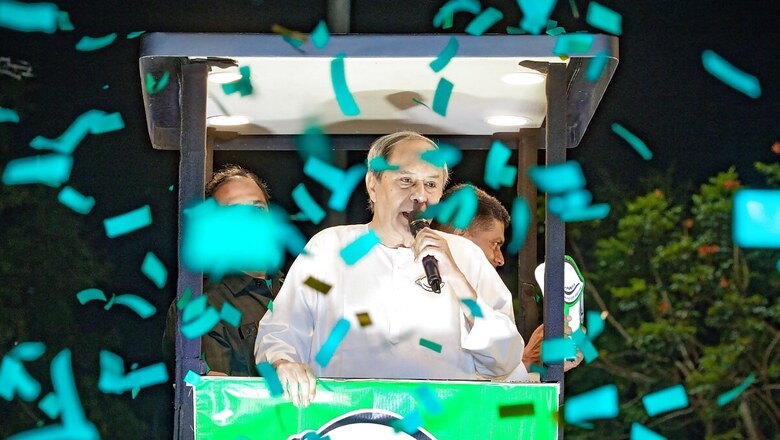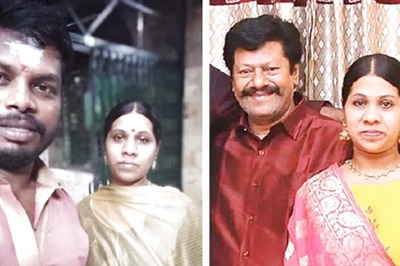
views
The BJP on Tuesday stormed into power in Odisha, ending the 24-year reign of BJD leader Naveen Patnaik. Proving all political analysts wrong, the Bharatiya Janata Party in a huge leap won 78 of the 147 seats in the Assembly, trouncing the Biju Janata Dal (BJD) which also failed to win even a single seat in the Lok Sabha elections. Patnaik, five-time Odisha CM, had to return from the cusp of making history as the longest serving chief minister in India. This was Patnaik’s first election defeat in his over 25-year political career.
Naveen Patnaik had taken oath as Odisha Chief Minister for the first time in 2000 and had an unchallenged rule with five consecutive terms. However, the epochal mistake that he made was letting his non-Odia and Tamil Nadu-born ex-IAS officer take the lead in the 2024 campaign. There was palpable concern on the ground as discussions raged on in panchayat after panchayat over whether to give the ageing chief minister another chance and risk handing over the affairs of the state to someone, who though recognized for his steller work, was widely perceived as an ‘outsider’.
Twenty-four years since his first oath, 78-year-old Patnaik remains a ‘father figure’, fondly called ‘Nabina’. But there were real issues on the ground, with his close aide VK Pandian assuming power in the government and party that was disproportionate to the position he held. Apart from the Odia pride factor, there were fears of jobs and contracts going to outsiders and there were murmurs within the BJD itself about whether Naveen Patnaik was grooming an ex-bureaucrat to take over the reins of the government and party.
The BJP and the Congress exploited this issue to the hilt, but it was the Narendra Modi factor that turned the tide in the saffron party’s favour.
Towards the end of February, alliance talks between the BJD and the BJP had scorched the state, triggering questions on both the necessity and political wisdom in the ruling party and the opposition coming together to fight an election.
Though Patnaik had always said that the BJD is equidistant from the both the Congress and the BJP, the fact is that the party has always bailed out the BJP-led NDA on contentious legislations like the abrogration of Article 370 and even the Delhi Services Bill. It had been an undeclared ally of the of BJP at the Centre.
However, on March 22, BJP state president Manmohan Samal ended the suspense and said there would be no alliance between the BJD and the BJP. He thanked Patnaik for his support at the Centre all these years. Samal went on to declare that the BJP would fight all 21 Lok Sabha seats and 147 Vidhan Sabha seats on its own. His announcement was greeted with jubilation at the BJP’s party office but no such joy was visible in the BJD office.
Meanwhile, the Congress, which once ruled the state and has been out of power since 2000, sensed an opportunity. Playing on the proximity of the BJD and BJP, it tried to portray itself as the true opposition in the state. Barely a month later, in mid-April, senior Congress leader and Wayanad MP Rahul Gandhi kicked off the party’s campaign in Kendrapara and coined an acronym – PANN — to take on the BJD and BJP.
“Over here (Odisha), BJD and BJP are bound by marriage or you may call it partnership. They are together, and in this marriage, they have given PANN to the people of Odisha,” he said. The ‘PANN’ referred to VK Pandian, Amit Shah, Narendra Modi and Naveen Patnaik.
Patnaik had fended off the Modi wave twice before in 2014 and 2019. In 2019, when Patnaik was seeking his fifth consecutive term in the Assembly elections, the BJD’s vote share had risen to 44.7%, from 43.4% in 2014. With 112 wins, it was down by just five seats compared to 2014.
The BJP won 23 Assembly constituencies in 2019, which was an addition of 13 compared to 2014 and emerged as the main opposition in the state. At 32.5%, the BJP added an impressive vote share, compared to 18% in 2014.
The Congress won just nine of the 147 seats; its vote share nosedived from 25.7% in 2014 to 16.1% in 2019. As far as the 21 Lok Sabha constituencies go, the BJD won 12 in 2019, down from the 20 in 2014. In terms of vote share, the regional party got 42.8%, compared to 44% in 2014. The BJP won an impressive eight Lok Sabha constituencies, up from just one in 2014. In terms of the vote share, the BJP gained significantly at 38.4%, from 21.55% in 2014. The Congress won just one Lok Sabha constituency, its vote share dipping from 26% in 2014 to 13.8% in 2019.
Patnaik, aiming for his sixth consecutive term, had kicked off the BJD’s campaign from home turf Hinjli in the Aska parliamentary constituency on April 25, almost 40days after election dates were announced and more than a month after alliance talks were called off. In an echo of the BJP’s campaign, Patnaik promised to make the state No.1 by its centenary year 2036. He promised a youth budget and spoke of ‘5T Nabin’ guarantee. He cast the opposition as “anti-development” and appealed to the people to vote for “Jodi Shankha” (twin conch).
“Jodi Shankha is the symbol of Odisha, symbol of development. With your support, the BJD will score a thumping victory in the Vidhan Sabha and do well in the Lok Sabha. Our victory procession will continue,” he said.
This speech perhaps was the longest that Patnaik delivered in this election season, the rest being a little over five minutes where he simply asked whether the various welfare schemes of his government were good and then asked whether Naveen Patnaik is good. In a repeat of the 2019 strategy, when he had contested from Hinjili and Bijepur constituencies, Patnaik contested from two seats this time too — Hinjili and Kantabanji.
However, unlike 2019, there was a tectonic shift in Naveen Patnaik’s campaign. And that was the presence of Pandian in every frame with Patnaik. The suave and politically astute Patnaik had never shared space with any other BJD leader in any fashion during his political career. So pervasive was Pandian’s presence that even while Patnaik gave the few speeches that he did, Pandian was in the frame holding a mic even though the podium already had one.
A video of Pandian sharply moving away Patnaik’s trembling left hand from public glare went viral and provided ammunition to the opposition’s charge that it was a non-Odia who was ruling the state and that Patnaik was no longer in control.
Close to the chief minister in his role as a bureaucrat, Pandian had taken voluntary retirement in October 2023, fuelling speculation that he would be the successor of Naveen Patnaik, since the latter is a bachelor and has no heirs. The Congress ran a campaign calling for ‘Odisha for Odias’, while the BJP termed the elections a ‘fight for Odisha’s Asmita (pride)”.
Prime Minister Narendra Modi spearheaded the BJP’s campaign, addressing 10 rallies across the state. On May 6, addressing a rally in Naveen Patnaik’s home turf Berhampur, the PM said: “Once the BJP government is formed, we will implement all our promises and this is Modi’s guarantee. The BJD’s expiry date is June 4. Today is May 6, and on June 6, the BJP will decide its chief ministerial face. On June 10, the BJP chief minister will take oath in Bhubaneswar. I am here to invite you all to attend the oath-taking ceremony.”
In his second rally that very day in Nabrangpur, the prime minister said: “Odisha will get its first CM from the BJP. The chief minister will be a son or daughter of Odisha and not an outsider.”
The same day, Pandian said Naveen Patnaik will take oath on June 9.
In a clever strategy, the BJP trained its guns not on Naveen Patnaik as he still remains dear to the people, but on Pandian. In fact, Modi announced that if BJP forms the government, he would form a committee that would investigate how the health of Naveen Patnaik had deteriorated so sharply in the past one year. And Patnaik, addressing a rare press conference, responded by saying that if Modi was his good friend as he has stated publicly, he could have just picked up the telephone and called him to enquire about his health. BJP unleashed its top leaders Amit Shah, Himanta Biswa Sarma and Nitin Gadkari to drive home the point.
For reasons best known to Patnaik, Pandian and the BJD, even though the party had 38 other star campaigners, only Pandian was visible giving big ticket interviews, campaigning across the state, addressing important press conferences, answering the BJP’s charges and even shooting counter questions. It was Pandian who had asked the BJP who would be its chief ministerial candidate.
The chief minister could have responded to the BJP’s charge in his political speeches, if not interviews, but he did not do so. In fact, Patnaik’s only interview this election season was on the last day of campaigning before the last phase of polls where he clarified that Pandian was not his successor. The damage was done by then.
It was the plethora of welfare schemes of the Naveen Patnaik government and the CM’s own personal connect with the people that saved BJD from a complete rout.



















Comments
0 comment